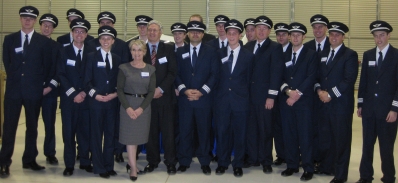“I know you’ve never done this before, but why don’t you already know how to do this?”
I don’t know if that was ever said, but it’s what I felt. Right before I realised my, good enough study habits that got me through high school and flight school were underdeveloped and having me come up short.
Most aircraft endorsements typically include about 10 simulator sessions of 3 to 4 hours shared between 2 trainee first officers.
Followed by a skills test with a regular line Captain supporting from the left seat.
I have left many Simulator sessions mentally and physically exhausted. They can be intense and brutal like a mental and physical workout. But they can also be super fun.

All of the easy familiarization things had been covered in the first two simulator sessions. Mostly what we’d been able to practice on a paper tiger (a mock cockpit made of paper) at home and stuff that wasn’t too procedural; basic handling and so on. so I could just follow the instructor and wing it, learning ‘on the fly’ to get through.

Our third session was more procedural. We were practicing rapid depressurisation and emergency descent procedures, which require a number of steps in sequence, like a choreographed dance. Needless to say, I didn’t know all the steps. To be honest, I either completely forgot, didn’t even know to or totally overlooked, studying to understand and memorize the steps before the session in the first place. Maybe I thought the instructor was going to spoon-feed us. Maybe I was just overwhelmed with a workload higher than I’d expected or ever experienced. Or I was just being dumb and ignorant.
Fortunately, I am pretty good at “watch and repeat” and I probably do rely on it a little too much. Either way, I was sharp enough to let my buddy go first since the instructor didn’t demonstrate, so I could watch him.
Then it was my turn to copy. I managed to bullsh*t my way through 80% of it. Oxygen mask on, start the descent to 10,000feet, etc. But then; the turn 45° off track for 1minute to establish a parallel track offset. I misunderstood for; a 45° degree angle of bank turn for 1minute. So, I rolled into a steep turn maneuver and turned about 220° off track. I actually nailed it… I just nailed the completely wrong target. The trainer stopped the simulator. I don’t remember his words… but it was probably along the lines of “WTF are you doing?” It was quite obvious I didn’t study properly beforehand. It was pretty damn embarrassing.
Sometime after this, I was reminded of two important lessons, Just about everything you need to know is written in books somewhere. And, flight Training is always flight Testing, because you don’t start lesson 2 until you complete/pass lesson 1, and so on.

So here is the best piece of advice I can give to a student or pilot in training (and I’m sure its sound advice that applies to many other learning applications too):
- Lead your own education or training. Don’t rely on the teacher to feed you information, simply use them as a respected guide and resource.
To quote, author and ex-Navy SEAL Commander, Jocko Willnik – “Take extreme ownership”.
- Find out in advance what you will be covering in each lesson. ie, always have the course plan on hand and lesson plan for each class, flight, or Sim session.
- Be outcome-focused, i.e. today’s class/Sim we need to perform successfully A B C and D (found on the lesson plan) to progress to the next lesson. That way nothing is a surprise and you can just go and check the boxes off.
- What information and procedures do I need, to be able to perform A B C and D successfully. Then go find the information in the manuals, preview, and rehearse if needed.
This will allow you to turn up to your Instructor or teacher with all the knowledge and right building blocks ready to go. All he/she should do is help you put them together, help you build your own skills, and maybe contribute an occasional missing block.
Having your teacher go find and show you all your building blocks, is a waste of time! do yourself a favor, be a great student, and get the best out of your teacher.
At the end of each session’s debrief, confirm with your instructor, what you’ll be covering tomorrow, they might even tell you where to find the building blocks that you’ll need for tomorrow’s session.
Then go home, review today’s lesson if needed. Then find tomorrow’s building blocks, preview, and rehearse, so you can hit the ground running to check the boxes again tomorrow. Oh, and get some rest.
“Prior preparation, prevents poor performance” – Almost every Training Captain I’ve met.
Personally, I didn’t do this in my Saab 340 endorsement and first officer training. I also really suffered because of it. I only figured out this strategy and structure later in my career. And hopefully, I remember next time I’m doing an endorsement or upgrade and drowning in information.
“Structure and discipline result in freedom” remember that.
In Aviation, these building blocks are our Standard operating procedures or SOPs. They are the backbone of aviation. In the simulator, we can practice these SOPs, maneuvers, and simulated emergencies in a safe controlled environment.
Click here for a short video of pilots practicing an emergency

So when you’re not getting your butt kicked and brain saturated with new information. The Simulator is actually really enjoyable. It is always an invaluable resource that builds experience and can confidence rapidly. For example, you could practice 5 landings in 10 minutes. In the real world, that would take an hour to get the same focused practice.
And on those days that we finish our training efficiently, we sometimes get a chance to have some fun. Barrel roll? No worries! Fly UNDER the Sydney harbor bridge? too easy. 50 foot fly by at 300knots? you bet. Can we try gliding it onto the runway, with both engines failed? You bet your ass we can try that! All the fun things you can do when your instructor doesn’t have to waste time showing you where to find building blocks.

These fun extras we occasionally get to do in the simulator, I have found to be surprisingly beneficial when it comes to confidence and handling. Even though I’ll never practically do it in the real world. The exercise lets you see outside of the envelope of normal operation. Therefore you’re less startled and more confident if you do ever find yourself outside the envelope. Which should lead to a better reaction, decision and outcome.
Fortunately that day, with a bit of retraining and block finding, I got through the training session and continued on to complete my endorsement with one extra training session to improve my new skills and gain some more confidence. Far from perfect, but good enough.
Now, for the real deal. Flying the real aircraft!





 Yes, some airlines may collapse, pilots and crew will lose work and revenue and salaries will be lost. My heart goes out to everyone affected. Always remember; spring will return and we will rebuild. We will then probably see another 8 or 10 years of growth, before winter returns (another crisis) that wi
Yes, some airlines may collapse, pilots and crew will lose work and revenue and salaries will be lost. My heart goes out to everyone affected. Always remember; spring will return and we will rebuild. We will then probably see another 8 or 10 years of growth, before winter returns (another crisis) that wi


 I’ll be sitting there having a quiet moment to myself, watching a beautiful sunrise from 35,000 feet. And I’ll remember; I am in control of a Boeing 777! A 300million dollar, 300ton, technologically mind-blowing flying machine! Hauling across the sky and around the world at Mach 0.84(900km/h). Powerful, Free and Adventurous!
I’ll be sitting there having a quiet moment to myself, watching a beautiful sunrise from 35,000 feet. And I’ll remember; I am in control of a Boeing 777! A 300million dollar, 300ton, technologically mind-blowing flying machine! Hauling across the sky and around the world at Mach 0.84(900km/h). Powerful, Free and Adventurous! (I used to have similar moments at 15000feet in a 13ton SAAB340 or 5000ft in a PA-28)
(I used to have similar moments at 15000feet in a 13ton SAAB340 or 5000ft in a PA-28)
